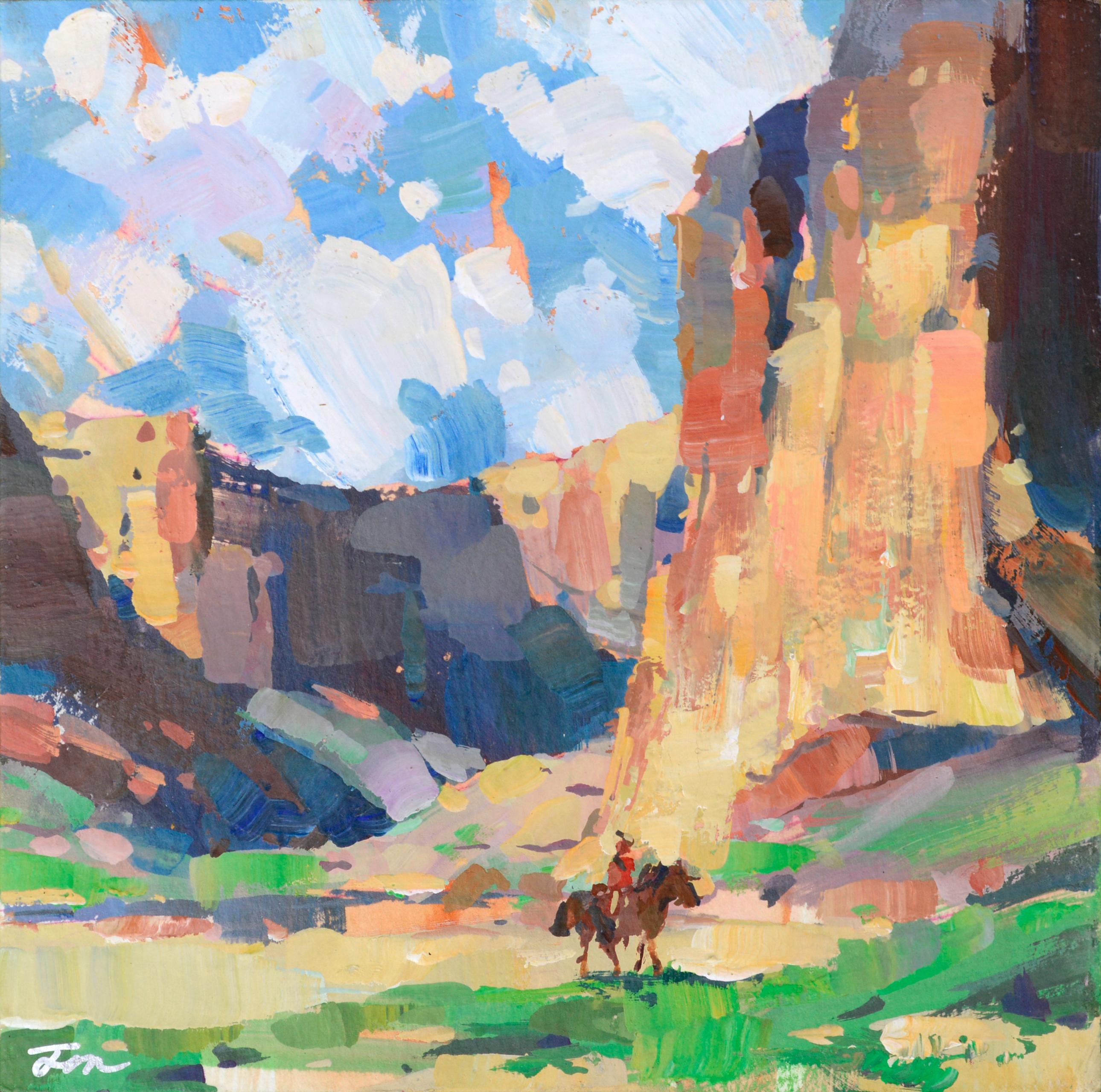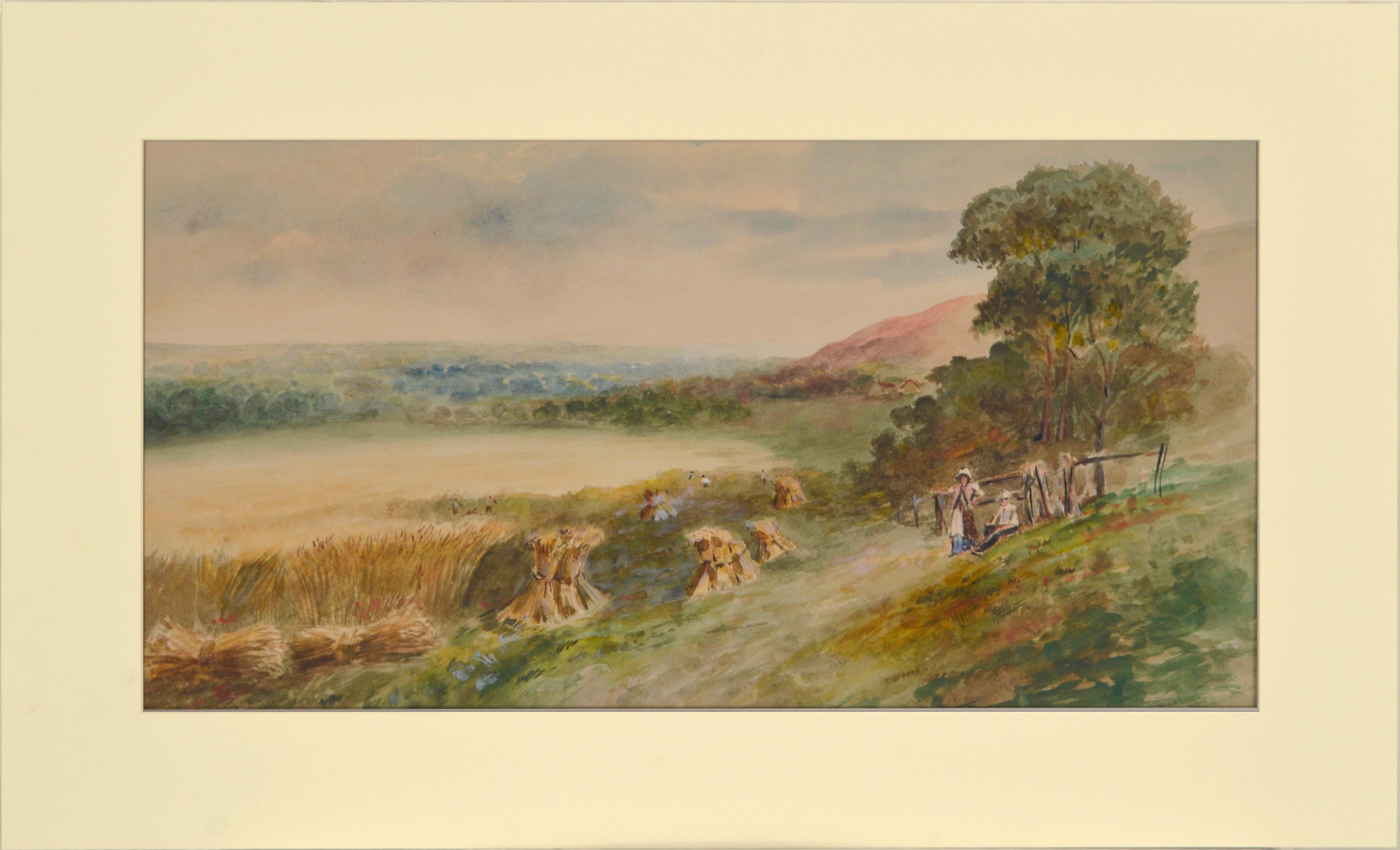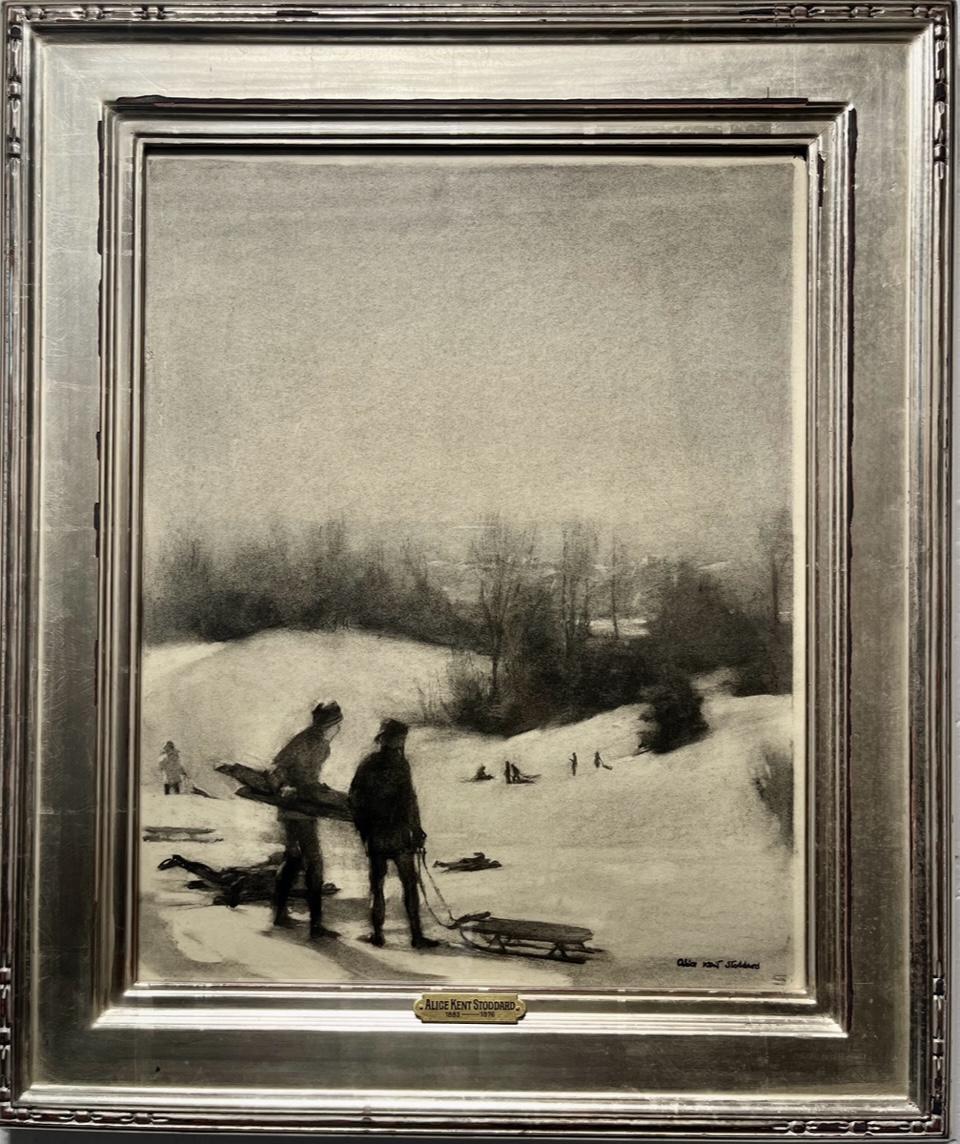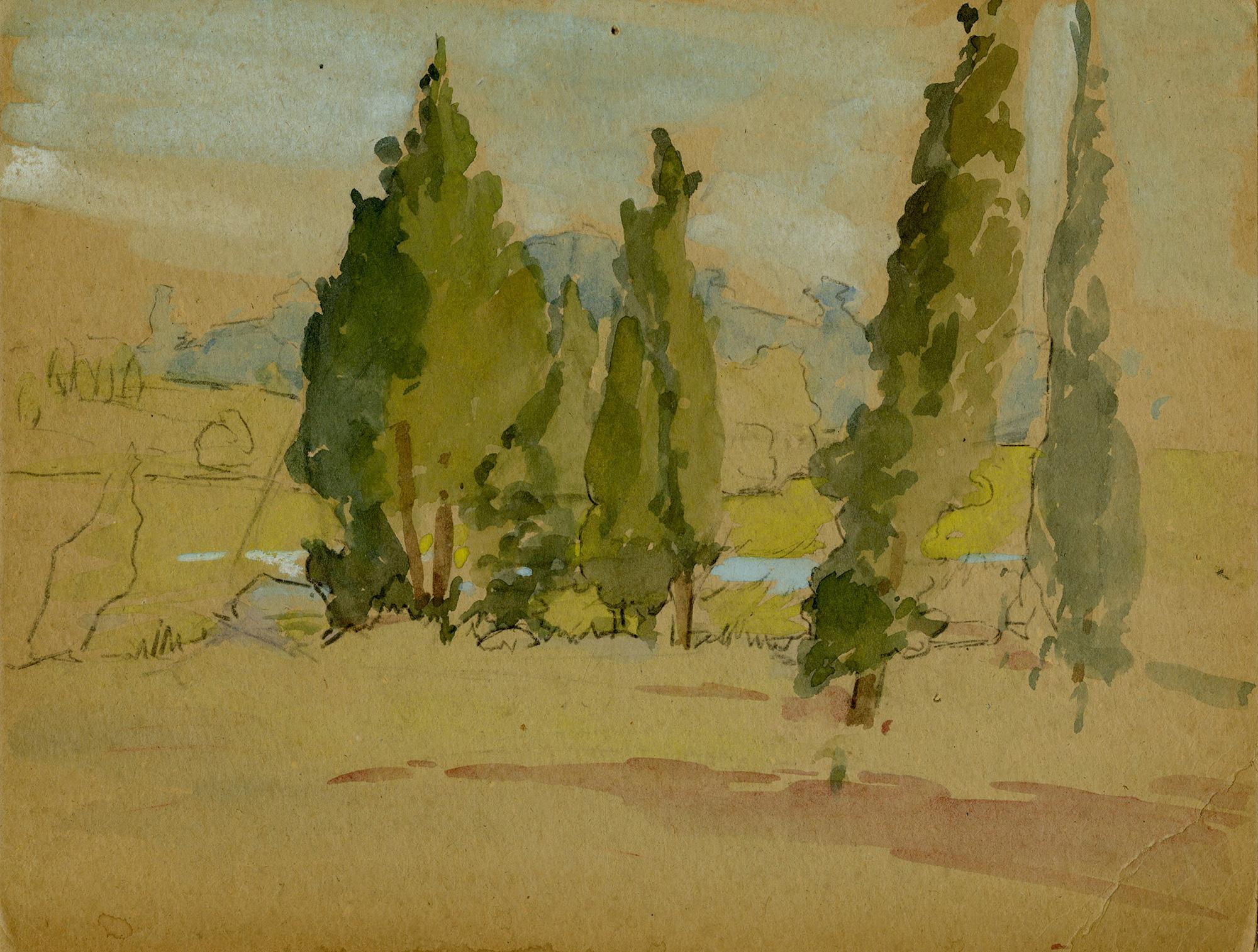Joseph YeagerCountry Lane in the Pine Forest - Mid Century Landscape Watercolorc.1950s-1960s
c.1950s-1960s
About the Item
- Creator:Joseph Yeager (1892 - 1958, American)
- Creation Year:c.1950s-1960s
- Dimensions:Height: 22 in (55.88 cm)Width: 30 in (76.2 cm)Depth: 0.03 in (0.77 mm)
- Medium:
- Movement & Style:
- Period:
- Condition:Mild tonal ageing to paper, as expected for a piece of this age.
- Gallery Location:Soquel, CA
- Reference Number:
Joseph Yeager
Joseph "Joe" Yeager was raised in Cleveland, Ohio, where he went to art school at night and started his art career at 19. He was a commercial artist for the Cleveland Press for seven years, and then worked as the paper’s art director for another seven. In the army, he was a technical research illustrator for the National Advisory Committee for Aeronautics. Yeager later moved to Medina, Ohio, in 1941, and opened Joe Yeager Industrial Design in 1947. He also taught advanced perspective at the Cleveland School of Art.
(Biography provided by Robert Azensky Fine Art)
- ShippingRetrieving quote...Ships From: Soquel, CA
- Return PolicyA return for this item may be initiated within 14 days of delivery.
- Mid Century California Mission LandscapeLocated in Soquel, CABeautiful mid century landscape of a historic California mission, highlighting its iconic architectural details such as a columned arches, white was...Category
Mid-20th Century American Impressionist Landscape Paintings
MaterialsGouache, Cardboard, Paper
- Cowboy in the Canyon, Small Contemporary Multicolor Abstract Figural LandscapeBy Tiffanie MangLocated in Soquel, CASmall-scale yet bold multi-colored abstracted figurative landscape of a horse rider in a canyon (a study after Edgar Payne’s works) by Tiffanie Mang (Ameri...Category
2010s American Impressionist Figurative Drawings and Watercolors
MaterialsCardboard, Gouache
- Harvest Time The Hills of Mt Tamalpais near Lake Bon Tempe 1890sLocated in Soquel, CAHarvest Time The Hills of Mt Tamalpais near Lake Bon Tempe 1890s The Hills around San Rafael in the 19th century were a time of work and play as seen in this watercolor near Lake Bon...Category
Late 19th Century American Impressionist Figurative Drawings and Waterco...
MaterialsIllustration Board, Watercolor, Laid Paper
- Botanical Study Autumn Grape Leaves #2By Les AndersonLocated in Soquel, CAColorful study of grape leaves in autumn with abstracted elements and a pink/magenta background by California artist Les (Leslie Luverne) Anderson (American, 1928-2009). From the est...Category
Late 20th Century American Impressionist Landscape Drawings and Watercolors
MaterialsWatercolor, Laid Paper
- Zen Garden, Figurative Landscape with Buddah Sculpture & PlantsBy Les AndersonLocated in Soquel, CASerene figurative landscape of a Zen sculpture garden surrounded by mountains and trees by Les (Leslie Luverne) Anderson (American, 1928-2009). From the estate of Les Anderson in Mon...Category
1980s American Impressionist Figurative Drawings and Watercolors
MaterialsPaper, Watercolor
- Sculpture Garden LandscapeBy Les AndersonLocated in Soquel, CASerene figurative landscape of a sculpture garden full of plants and architectural elements by Les (Leslie Luverne) Anderson (American, 1928-2009). From the estate of Les Anderson in...Category
1980s American Impressionist Figurative Drawings and Watercolors
MaterialsPaper, Watercolor
- Sledders - Winter Snow Scene - Kids playing on Sleds, Charcoal drawing c 1950-60By Alice Kent StoddardLocated in Rancho Santa Fe, CAAlice Kent Stoddard 1885-1976 Sledders (circa 1950-1960) Black chalk on card Image Dimensions: 19.75 x 16 inches (50.2 x 40.6 cm) Framed Dimensions: 26.5 x 22.3 inches Signed lower right: Alice Kent Stoddard Alice Kent Stoddard was born in Connecticut, but spent much of her career as an artist in Philadelphia and on Monhegan Island in Maine. She studied with Thomas Eakins, William Merritt Chase and Thomas Anshutz at the Pennsylvania Academy of Fine Arts, as well as at the Philadelphia School of Design for Women. While serving with the YMCA in France during World War I, Stoddard executed many drawings and paintings of the battlefield. However, she is most widely recognized for her bold landscapes and marine paintings of Maine...Category
Mid-20th Century American Impressionist Figurative Drawings and Watercolors
MaterialsCharcoal, Cardboard
- Pine trees in a river valley with the Blue Ridge Mountains - American SchoolLocated in Middletown, NYAn unfinished but spirited plein-air composition of what appears to be the Shenandoah or Potomac River valley with the Blue Ridge Mountains in the distance. Watercolor on board with...Category
Early 1900s American Impressionist Landscape Drawings and Watercolors
MaterialsCrayon, Watercolor, Board
- "House on a Hill, " Clara Bell, Female Artist Landscape, American ImpressionismLocated in New York, NYClara Louise Bell (1886 - 1978) House on a Hill, circa 1935 Gouache on artist board 7 1/4 x 9 7/8 inches Clara Louise Bell (Mrs.Bela Janowsky) was b...Category
1930s American Impressionist Landscape Paintings
MaterialsGouache, Board
- Pennsylvania Farmhouse, American Impressionist Landscape, Watercolor on PaperBy Albert Van Nesse GreeneLocated in Doylestown, PA"Pennsylvania Farmhouse" is a beautiful spring landscape with rolling hills and countryside farmhouses. The watercolor on paper is painted by American Impressionist Albert Van Nesse Greene. The painting is a 14" x 19" watercolor on paper, matted, framed under glass, and signed "A V Greene...Category
Early 20th Century American Impressionist Landscape Drawings and Waterco...
MaterialsWatercolor, Archival Paper
- "Train Station, " Max Kuehne, Industrial City Scene, American ImpressionismBy Max KuehneLocated in New York, NYMax Kuehne (1880 - 1968) Train Station, circa 1910 Watercolor on paper 8 1/4 x 10 1/4 inches Signed lower right Provenance: Private Collection, Illinois Max Kuehne was born in Halle, Germany on November 7, 1880. During his adolescence the family immigrated to America and settled in Flushing, New York. As a young man, Max was active in rowing events, bicycle racing, swimming and sailing. After experimenting with various occupations, Kuehne decided to study art, which led him to William Merritt Chase's famous school in New York; he was trained by Chase himself, then by Kenneth Hayes Miller. Chase was at the peak of his career, and his portraits were especially in demand. Kuehne would have profited from Chase's invaluable lessons in technique, as well as his inspirational personality. Miller, only four years older than Kuehne, was another of the many artists to benefit from Chase's teachings. Even though Miller still would have been under the spell of Chase upon Kuehne's arrival, he was already experimenting with an aestheticism that went beyond Chase's realism and virtuosity of the brush. Later Miller developed a style dependent upon volumetric figures that recall Italian Renaissance prototypes. Kuehne moved from Miller to Robert Henri in 1909. Rockwell Kent, who also studied under Chase, Miller, and Henri, expressed what he felt were their respective contributions: "As Chase had taught us to use our eyes, and Henri to enlist our hearts, Miller called on us to use our heads." (Rockwell Kent, It's Me O Lord: The Autobiography of Rockwell Kent. New York: Dodd, Mead and Co., 1955, p. 83). Henri prompted Kuehne to search out the unvarnished realities of urban living; a notable portion of Henri's stylistic formula was incorporated into his work. Having received such a thorough foundation in art, Kuehne spent a year in Europe's major art museums to study techniques of the old masters. His son Richard named Ernest Lawson as one of Max Kuehne's European traveling companions. In 1911 Kuehne moved to New York where he maintained a studio and painted everyday scenes around him, using the rather Manet-like, dark palette of Henri. A trip to Gloucester during the following summer engendered a brighter palette. In the words of Gallatin (1924, p. 60), during that summer Kuehne "executed some of his most successful pictures, paintings full of sunlight . . . revealing the fact that he was becoming a colorist of considerable distinction." Kuehne was away in England the year of the Armory Show (1913), where he worked on powerful, painterly seascapes on the rocky shores of Cornwall. Possibly inspired by Henri - who had discovered Madrid in 1900 then took classes there in 1906, 1908 and 1912 - Kuehne visited Spain in 1914; in all, he would spend three years there, maintaining a studio in Granada. He developed his own impressionism and a greater simplicity while in Spain, under the influence of the brilliant Mediterranean light. George Bellows convinced Kuehne to spend the summer of 1919 in Rockport, Maine (near Camden). The influence of Bellows was more than casual; he would have intensified Kuehne's commitment to paint life "in the raw" around him. After another brief trip to Spain in 1920, Kuehne went to the other Rockport (Cape Ann, Massachusetts) where he was accepted as a member of the vigorous art colony, spearheaded by Aldro T. Hibbard. Rockport's picturesque ambiance fulfilled the needs of an artist-sailor: as a writer in the Gloucester Daily Times explained, "Max Kuehne came to Rockport to paint, but he stayed to sail." The 1920s was a boom decade for Cape Ann, as it was for the rest of the nation. Kuehne's studio in Rockport was formerly occupied by Jonas Lie. Kuehne spent the summer of 1923 in Paris, where in July, André Breton started a brawl as the curtain went up on a play by his rival Tristan Tzara; the event signified the demise of the Dada movement. Kuehne could not relate to this avant-garde art but was apparently influenced by more traditional painters — the Fauves, Nabis, and painters such as Bonnard. Gallatin perceived a looser handling and more brilliant color in the pictures Kuehne brought back to the States in the fall. In 1926, Kuehne won the First Honorable Mention at the Carnegie Institute, and he re-exhibited there, for example, in 1937 (Before the Wind). Besides painting, Kuehne did sculpture, decorative screens, and furniture work with carved and gilded molding. In addition, he designed and carved his own frames, and John Taylor Adams encouraged Kuehne to execute etchings. Through his talents in all these media he was able to survive the Depression, and during the 1940s and 1950s these activities almost eclipsed his easel painting. In later years, Kuehne's landscapes and still-lifes show the influence of Cézanne and Bonnard, and his style changed radically. Max Kuehne died in 1968. He exhibited his work at the National Academy of Design, the Art Institute of Chicago, the Carnegie Institute in Pittsburgh, the Memorial Art Gallery of the University of Rochester, and in various New York City galleries. Kuehne's works are in the following public collections: the Detroit Institute of Arts (Marine Headland), the Whitney Museum (Diamond Hill...Category
1910s American Impressionist Landscape Drawings and Watercolors
MaterialsPaper, Watercolor
- 'Santa Barbara Landscape', Paris, Académie Julian, LACMA, Pasadena, CaliforniaLocated in Santa Cruz, CASigned lower left, 'J. W. Nicoll' for John W. Nicoll (American, 1865-1943), titled lower left, 'Santa Barbara' and painted circa 1925. Sheet dimensions: 9 x 12.75 inches. A luminous, early twentieth-century landscape showing a picturesque view of a Spanish style cottage set in a lush garden with a view beyond towards the Santa Ynez Mountains rising towards clouded, blue skies. An unusual and elegant view of old-time Santa Barbara that retains much of its crispness and freshness of color. Born in New York, John Nicoll first studied with his uncle, the landscape painter, James Nicoll. He subsequently moved to Paris where he furthered his education for three years under Bouguereau and Ferrier at the Académie Julian. He then continued on to Seville where he studied for three years at the Academia Real, spending his winters traveling and painting in North Africa. By 1899, Nicoll had settled in Pasadena where he painted, exhibited and taught drawing at the College of Fine Arts from 1906-1935. Upon his retirement, he moved to San Diego where he continued to paint and exhibit until his death in 1943. Over the course of a long career, James Nicoll exhibited widely and with success including at the Stickley Building, Pasadena, 1899; Blanchard Hall, Los Angeles, 1899; the Louisiana Purchase Exposition, St Louis, 1904; the Ruskin Art Club, Los Angeles, 1904; Lewis & Clark Expo Portland, 1905 (Bronze Medal); the Painters Club, Los Angeles, 1906-09; the Nicholson Gallery...Category
1920s American Impressionist Landscape Drawings and Watercolors
MaterialsPaper, Watercolor






